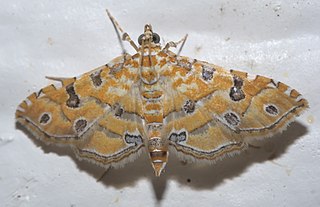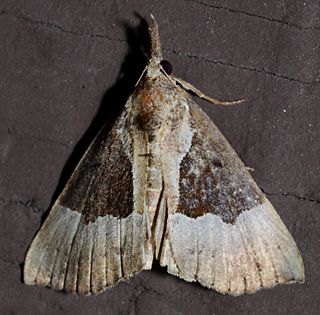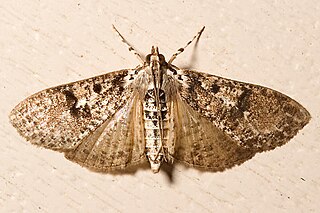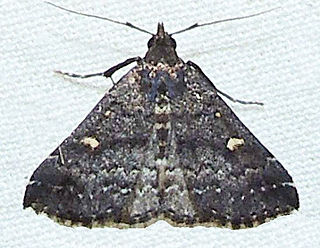
Hypena is a genus of moths in the family Erebidae. It was first described by Franz von Paula Schrank in 1802. These non-migratory moths overwinter as pupae and almost never estivate as adults.

Omiodes is a moth genus in the family Crambidae. Several species are endemic to Hawaii.
Cryptobotys is a monotypic moth genus of the family Crambidae described by Eugene G. Munroe in 1956. Its only species, Cryptobotys zoilusalis, was described by Francis Walker in 1859. It is found in Cuba, Jamaica, Puerto Rico, Central America and the southern United States, where it has been recorded from Florida.

Palpita is a genus of moths of the family Crambidae. Members of the moth genus Stemorrhages may be very similar in appearance.

Ommatospila narcaeusalis, the ommatospila moth, is a moth of the family Crambidae described by Francis Walker in 1859. It can be found in the southern parts of the United States, South America and several Caribbean islands, such as the Antilles and Jamaica.

Hypena bijugalis, the dimorphic bomolocha, dimorphic hypena or toothed snout-moth, is a moth of the family Erebidae. The species was first described by Francis Walker in 1859. It is found in North America from Nova Scotia across southern Canada to Vancouver Island, south over the whole United States to Florida.
Phytometra rhodarialis, the pink-bordered yellow, is a moth of the family Erebidae. The species was first described by Francis Walker in 1859. It is found from southern Ontario in Canada and Missouri and New Hampshire in the United States, south to Florida and Texas in the United States, possibly only as stray northward.

Palpita arsaltealis is a moth of the family Crambidae first described by Francis Walker in 1859. It is found in the north-eastern United States, south to South Carolina. It is also present in Quebec and Ontario.

Glyphodes sibillalis, the mulberry leaftier moth, is a moth of the family Crambidae. It is found in the southern United States, Central and South America and the West Indies.

Cydalima perspectalis or the box tree moth is a species of moth of the family Crambidae, first described by Francis Walker, the English entomologist, in 1859. Native to Japan, China, Taiwan, Korea, far-east Russia and India, it has invaded Europe; first recorded in Germany in 2006, then Switzerland and the Netherlands in 2007, Great Britain in 2008, France and Austria in 2009, Hungary in 2011, then Romania, Spain and Turkey. It has been seen in Slovakia, Belgium and Croatia.
Trischistognatha pyrenealis is a moth in the family Crambidae. It was described by Francis Walker in 1859. It is found in Mexico, Central America, the West Indies and the southeastern United States, where it has been recorded from Georgia to Florida and from Alabama to Texas.

Chalcoela pegasalis, the wasp parasitizer moth, is a moth in the family Crambidae. It was described by Francis Walker in 1859. It is found in Cuba, Jamaica, the French Antilles, Puerto Rico and also the United States and Canada.
Helvibotys helvialis is a moth in the family Crambidae. It was described by Francis Walker in 1859. It is found in North America, where it has been recorded from California to Florida, north in the east to Massachusetts, Quebec, Ontario, Michigan and Iowa.
Rhectocraspeda periusalis, the eggplant webworm moth, is a moth in the family Crambidae. It was described by Francis Walker in 1859. It is found in the West Indies and from the United States, where it has been recorded from Florida, North Carolina, Ohio, Oklahoma, South Carolina and Tennessee, south through Mexico and Central America to South America, including Ecuador, Brazil, Guyana, Trinidad and Tobago and Suriname.

Microtheoris ophionalis, the yellow-veined moth, is a moth in the family Crambidae. It was described by Francis Walker in 1859. It is found from southern Canada, through the United States and Mexico to South America.
Bicilia iarchasalis is a species of moth in the family Crambidae. It was described by Francis Walker in 1859. It is found in the south-eastern United States, where it has been recorded from Florida and Texas, as well as in Mexico, Cuba, the Dominican Republic, Puerto Rico and Venezuela.
Diacme mopsalis, the mopsalis diacme moth, is a moth in the family Crambidae. It was described by Francis Walker in 1859. It is found in South America, Central America, the Antilles and the southern United States, where it has been recorded from Arizona, Florida, Oklahoma and Texas.
Diacme phyllisalis is a moth in the family Crambidae. It was described by Francis Walker in 1859. It is found in Jamaica, Cuba and Mexico, as well the southeastern United States, where it has been recorded from Florida and Georgia.

Hypenula cacuminalis, the long-horned owlet moth, is a moth of the family Erebidae. The species was first described by Francis Walker in 1859. It is found from the south-eastern United States west to Texas and Arizona.

Margaroniini is a tribe of the species-rich subfamily Spilomelinae in the pyraloid moth family Crambidae. The tribe was erected by Charles Swinhoe and Everard Charles Cotes in 1889, originally as family Margaronidae.











